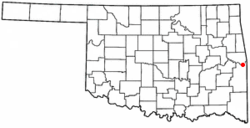Fort Coffee, Oklahoma | |
|---|---|
 Location of Fort Coffee, Oklahoma | |
| Coordinates: 35°17′39″N94°34′23″W / 35.29417°N 94.57306°W | |
| Country | United States |
| State | Oklahoma |
| County | Le Flore |
| Government | |
| • Type | Town |
| Area | |
• Total | 6.53 sq mi (16.91 km2) |
| • Land | 6.53 sq mi (16.91 km2) |
| • Water | 0.0039 sq mi (0.01 km2) |
| Elevation | 449 ft (137 m) |
| Population (2020) | |
• Total | 335 |
| • Density | 51.3/sq mi (19.82/km2) |
| Time zone | UTC-6 (Central (CST)) |
| • Summer (DST) | UTC-5 (CDT) |
| FIPS code | 40-27150 [3] |
| GNIS feature ID | 2412639 [2] |
Fort Coffee is a town in Le Flore County, Oklahoma, United States. Originally constructed as a U. S. Army fort in 1834, it was named for U. S. General John Coffee, a veteran of the Seminole Wars. [4] The population was 424 at the 2010 census, a gain of 2.9 percent over the figure of 412 in 2000. [5]
